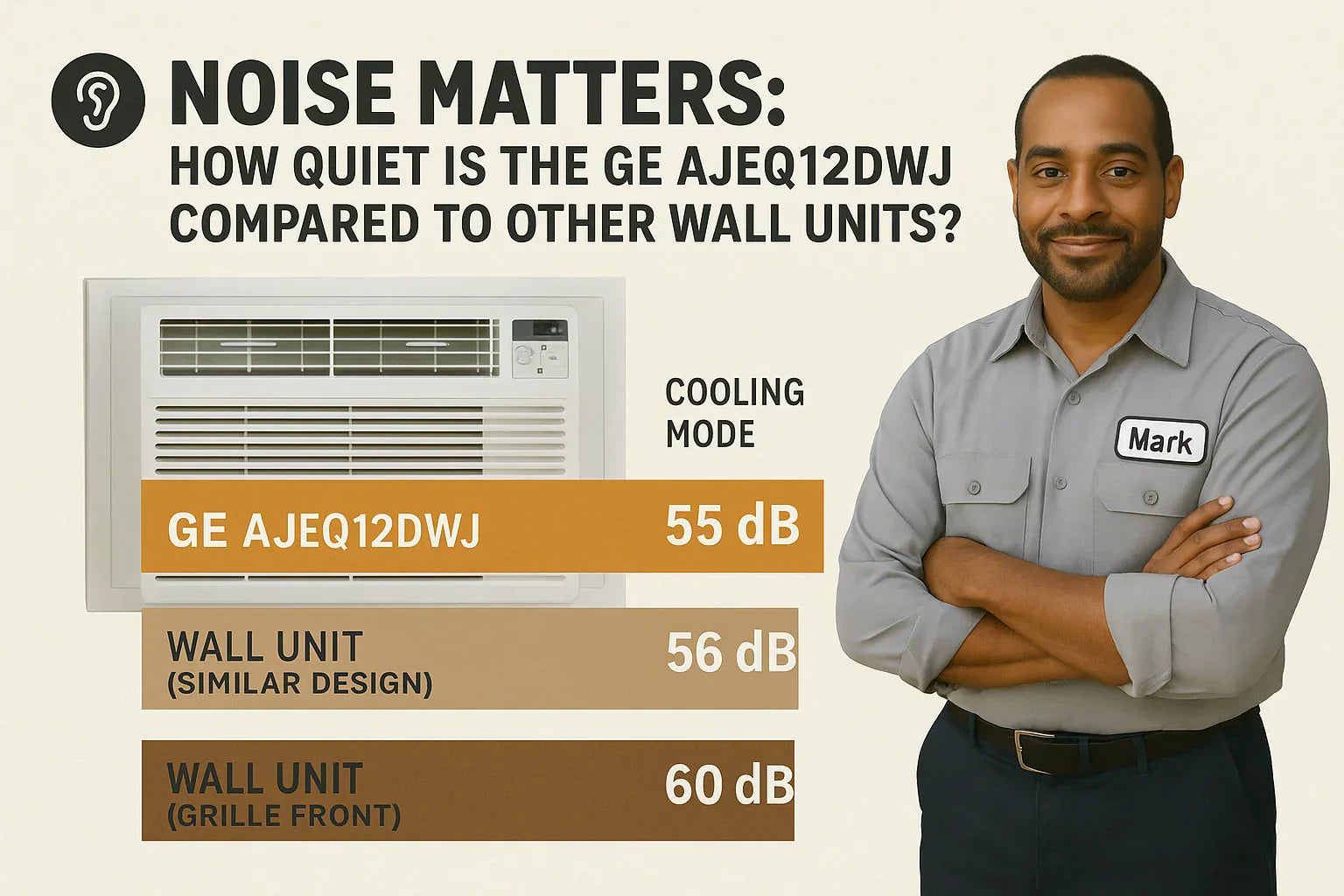If you’re planning to install a through-the-wall air conditioner in your bedroom, home office, or nursery, noise levels aren’t just a comfort preference—they’re a deal-breaker.
For homeowners like Mark, who values peace and quiet during the workday or overnight, the sound output of a wall unit like the GE AJEQ12DWJ can make or break the experience.
This article compares the decibel levels, sound design, and real-world quiet performance of the GE AJEQ12DWJ against top competitors like Friedrich, LG, and Frigidaire, helping you decide which unit is best for your space.
📢 What Is an Acceptable Noise Level for a Wall AC?
Noise is measured in decibels (dB). The lower the number, the quieter the unit.
Common Decibel Reference Points:
| Sound Level | dB(A) | Description |
|---|---|---|
| Whisper | 30 dB | Extremely quiet |
| Quiet conversation | 40–50 dB | Comfortable background sound |
| Average AC (low) | 50–55 dB | Acceptable for most |
| Average AC (high) | 60–65 dB | Audible hum or drone |
🔍 GE AJEQ12DWJ Noise Ratings
According to GE’s published specifications:
-
Low fan setting: ~56 dB
-
High fan setting: ~63 dB
GE Sound Design Features:
-
Two-fan speed system
-
Top-discharge airflow
-
Thick insulation within cabinet
-
Metal construction reduces rattle
While not the quietest wall unit on the market, the GE AJEQ12DWJ offers reasonable sound performance for mid-size rooms.
📊 GE vs. Friedrich vs. LG: Noise Comparison
| Model | Low Setting | High Setting | Notes |
| GE AJEQ12DWJ | ~56 dB | ~63 dB | Balanced design, sturdy frame |
| Friedrich Uni-Fit UCT12A10A | ~50 dB | ~59 dB | Quieter operation, foam-insulated chassis |
| LG LT1236CER | ~55 dB | ~62 dB | Comparable to GE, modern fan motor |
| Frigidaire FFTA123WA2 | ~57 dB | ~64 dB | Louder under full load |
📌 What Affects AC Noise Levels?
Internal Factors:
-
Fan speed and motor type
-
Compressor design
-
Internal insulation
-
Airflow direction (top discharge is quieter than front)
Installation Factors:
-
Wall sleeve vibration
-
Air leaks or improper sealing
-
Placement near corners or in echo-prone rooms
Mark’s Tip:
“Don’t just look at the numbers. A quiet model with bad insulation in the sleeve can rattle louder than a cheaper one that’s properly installed.”
🧠 Tips for a Quieter Experience
-
Use the low fan setting whenever possible
-
Install with a tight-fitting sleeve to avoid vibration
-
Seal all gaps with foam and caulk
-
Place unit away from corners to reduce echo
-
Consider a smart plug to schedule off times during sleep
🔗 How to Install a Wall AC Quietly
🎯 Is the GE AJEQ12DWJ Quiet Enough for Bedrooms or Offices?
Yes, if:
-
You’re comfortable with a low hum at 56 dB
-
You prioritize durability and cost-efficiency over ultra-quiet performance
-
You install the unit with proper insulation and sealing
No, if:
-
You are extremely sensitive to noise (e.g., light sleeper)
-
You’re comparing to a ductless mini-split (many operate at 25–35 dB)
🏁 Final Takeaway
While not whisper-quiet, the GE AJEQ12DWJ offers reliable, moderate sound levels suitable for most home offices, guest rooms, and primary bedrooms. Compared to similar 12,000 BTU wall units, it performs competitively—but those seeking the lowest possible decibel output may prefer Friedrich Uni-Fit models or consider ductless heat pumps.
For best results, pair your GE unit with a properly sized wall sleeve, weatherstripping, and a quiet fan setting, and you'll enjoy consistent comfort without intrusive noise.
In the next topic we will know more about: Is 12,000 BTUs Enough? How to Size a Through-the-Wall Unit for Your Room or Apartment







